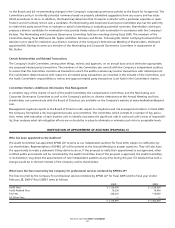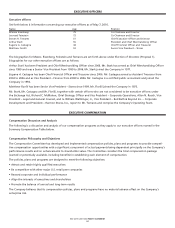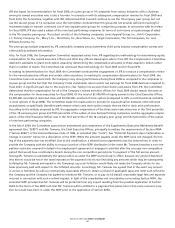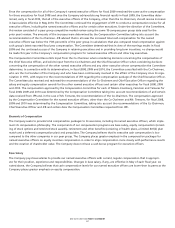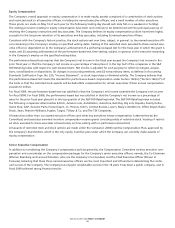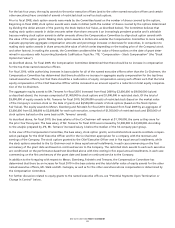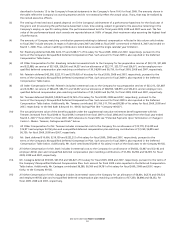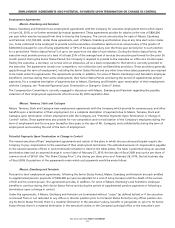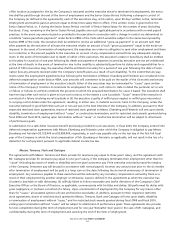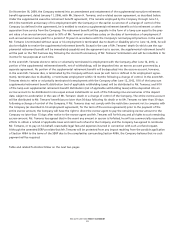Bed, Bath and Beyond 2009 Annual Report Download - page 48
Download and view the complete annual report
Please find page 48 of the 2009 Bed, Bath and Beyond annual report below. You can navigate through the pages in the report by either clicking on the pages listed below, or by using the keyword search tool below to find specific information within the annual report.BED BATH & BEYOND PROXY STATEMENT
46
JFR also based its recommendations for fiscal 2008 on a peer group of 14 companies from various industries with a chairman
among its named executives who is also a founder. In connection with its subsequent compensation reviews for fiscal 2009 and
fiscal 2010, the Committee, together with JFR, determined that it would continue to use the 18-company peer group, but not
use the second group of 14 companies since the Committee concluded that this group did not provide sufficient meaningful
incremental data to warrant continued use of two separate peer groups for comparison purposes. In connection with its review
for fiscal 2009, JFR also used a subset of the nine best performing companies (in terms of net income as a percentage of sales)
in the 18-company peer group. The subset consists of the following companies: Jones Apparel Group, Inc., Kohl’s Corporation,
J.C. Penney Company, Inc., Macy’s, Inc., Nordstrom, Inc., Ross Stores, Inc., Target Corporation, The TJX Companies, Inc. and
Williams-Sonoma, Inc.
The peer group analyses prepared by JFR used public company proxy statements, third party industry compensation surveys and
other publicly available information.
Also, for fiscal 2008, the Compensation Committee requested advice from JFR regarding the methodology for determining equity
compensation for the named executive officers and other key officers. Based upon advice from JFR, the Compensation Committee
deemed it advisable to grant stock option awards by determining the compensation allocated to these awards in dollars rather
than in number of shares. The Committee has continued that methodology for fiscal 2009 and for fiscal 2010.
In making its determinations for fiscal 2009, the Committee continued the engagement of JFR to conduct a compensation review
for the named executive officers and certain other executives. In reaching its compensation determinations for fiscal 2009, the
Committee took into account both the Company’s very strong performance during fiscal 2008 as compared to the companies in
its peer group and the fact that the Company’s total shareholder return and its net earnings for fiscal 2008 declined compared to
fiscal 2007, in significant part due to the economic crisis. Taking into account these factors and advice from JFR, the Committee
determined that the compensation for all of the Company’s named executive officers for fiscal 2009 should remain the same as
the compensation for those executives for fiscal 2008. Of the total of $7,000,000 of equity awards to the Chief Executive Officer,
$3,500,000 consisted of restricted stock and $3,500,000 consisted of stock options (compared to 34% in restricted stock and 66%
in stock options in fiscal 2008). The Committee made this reallocation to provide for equal allocation between restricted stock
awards based on specifically identified performance criteria and stock option awards that are tied to stock price performance.
According to the analysis prepared by JFR, the aggregate compensation of the three senior executives was in the 73rd percentile
of the 18-company peer group and 55th percentile of the subset of nine best performing companies, and the aggregate compen-
sation of the Chief Executive Officer was in the 73rd percentile of the 18-company peer group and 53rd percentile of the subset
of nine best performing companies.
In the fall of 2009, the Committee approved an amendment and restatement of the Supplemental Executive Retirement Benefit
agreement (the “SERP”) with Mr. Temares, the Chief Executive Officer, principally to address the requirements of Section 409A
(“Section 409A”) of the Internal Revenue Code of 1986, as amended (the “Code”). See “Potential Payments Upon Termination or
Change in Control” below for a description of the SERP. While the amounts payable under the SERP were not changed, the tim-
ing of the payments due was modified. Due to this modification, a related escrow agreement was also entered into in order to
provide the Company with the ability to recoup a portion of the SERP distribution in the event Mr. Temares breaches a non-com-
petition restrictive covenant included in his employment agreement or engages in activities after the one-year non-competition
period that would have constituted a breach during the non-competition period prior to payment of the full escrow amount,
leaving Mr. Temares in substantially the same position as under the SERP as previously in effect. Because any amount deposited
into escrow would be net of the taxes imposed on the payment into escrow (including any amounts which may be subsequently
forfeited by Mr. Temares and repaid to the Company), any such forfeiture would likely not make the Company whole for the
taxes previously paid with respect to the forfeited amounts. Accordingly, Mr. Temares has agreed that in the event any amount
in escrow is forfeited, he will use commercially reasonable efforts to obtain a refund of applicable taxes and remit such refund to
the Company and the Company has agreed to reimburse Mr. Temares, or to pay on his behalf, reasonable legal fees and expenses
incurred in connection with such a refund request. In light of the complexities and uncertainties surrounding Section 409A, the
amended SERP provides that Mr. Temares will be protected from any impact resulting from the possible application of Section
409A to the terms of the SERP such that Mr. Temares will be entitled to a payment that places him in that same economic posi-
tion he would have been in under the SERP prior to the application of Section 409A.








